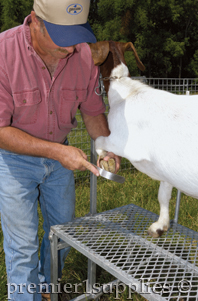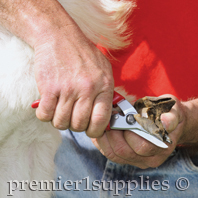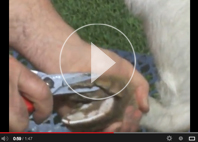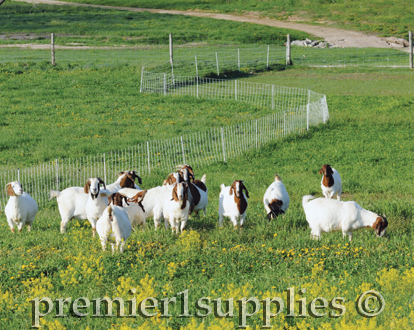

PREMIER’S TOP PICKS

Carl is using our hoof rasp to fine-tune the hooves of a Boer goat. Uneven cuts are like walking with a rock in your shoe, simply irritating. The trimming stand elevates the goat off the ground, reducing the strain on the trimmer’s back.
Trimming goat hooves?
Helpful items for caring for your caprine’s feet.
| 1. |
Hoof Rasp—Popular tool for putting the "finishing touches" on goat hooves. One side of the rasp is "coarse" for rapid removal, and the other side is "fine" for smoothing and finishing. |
| 2. |
Hoof Pincher—Long handles provide tremendous leverage to cut easily through tough, hard hooves. Superior to standard trimmers on rams and billies. |
| 3. |
The Premier™ Trimmer—Very strong—a requirement for breeds, conditions and species that are prone to or produce very hard hooves (adult goats, dry climates). Precision-ground, fine serrations. Excellent feel and balance. |
| 4. |
ARS 140DXR Trimmer—Choice of smooth or serrated blades. Regarded as the gold standard tool for trimming goat hooves. |
| 5. |
PowerParer®—Need a trimmer that makes light work of a hard job? Try our PowerParer, powered by air pressure instead of muscle. |

Premier’s ARS Trimmer in use.
See more foot trimming and care products.
HOOF TRIMMING HOW-TO’S
AND VIDEO

Hoof Trimming Hints
| 1. |
Before trimming, remove dirt/filth from the hoof. |
| 2. |
Check the hoof for sore spots and treat them as needed. |
| 3. |
Use a hoof trimmer with small blades to get under the curve of the hoof. |
| 4. |
Clip from back to front of the hoof. |
| 5. |
Make the cuts as smooth as possible. Remember, for the goat an uneven cut is like you walking around with a rock in your shoe that you can’t remove. |
| 6. |
When you get to the pink of the hoof, do not go deeper. Otherwise, you risk causing the hoof to bleed. |
| 7. |
When hoof trimming is done right, the goat should appear to be walking in high heels. You want a proud walk.
| • |
If cut too short on the inside, the goat’s legs will lean in, making it stand awkwardly. |
| • |
If cut too short on the outside, the goat will look bow-legged. |
| • |
If cut too low in back, the goat will lean back on the dew claw.
|
| • |
If cut too short in front, the goat will look like it is walking on tiptoe.
|
|
By Sara McArtor,
Premier Product Consultant
|
 |
 |

Our pregnant does graze cool-season grasses a few weeks prior to kidding. Be sure to keep up on hoof care so goats can graze soft soils.
It’s warm, it’s wet, it must be hoof trimming season!
We have fairly wet ground at Premier so we have to keep on top of hoof problems for all our stock—especially the goats.
If we forego hoof trimming, we risk having hoof rot/scald issues in our stock. This means added treatment beyond trimming (Kopertox or a Foot Bath). Goats tend to enjoy going through a foot bath even less than sheep.
HOW TO TRIM GOAT HOOVES
Hoof Trimming
By Gorge-Us Boer Goats
If you keep goats in the Northwest, you must trim their hooves.
The side walls to the goat’s hoof grow faster than they wear down and therefore need to be trimmed. In nature, the walls would get worn and trimmed naturally by the rocks the goat would be walking and climbing on. When the side wall grows long, it curves around and over the sole of the foot creating a place where dirt collects and rot can start. The whole point of trimming the goats foot is to keep it rot free as well as comfortable to walk on. You need to trim away all the places where dirt and rot can collect. Read More »
VIP ARTICLE
Want Goats? Start Here!
By Lesa Wilke
Think you’re seeing more goats lately? Well, it’s not your imagination. After chickens, goats are the fastest growing livestock animal in the US today. They’re increasingly popular on small farms and homesteads because they’re easy to care for and so useful. Goats don’t require pastures, are easily handled and housed, and can provide meat, milk, fiber, fertilizer, and brush control. Goat milk and meat are preferred over cow in most of the world, and folks in the US are starting to catch on in a big way.
Goat breeds are divided into three types: meat, dairy, and fiber—with several breeds readily available in the US within each type (see Table 1). Any of the breeds can be used for both meat and milk, but they’re classified according to their main usage. The meat breeds are taller and stockier, the dairy breeds lighter and more refined, and the fiber breeds typically fall somewhere in between. There’s also one breed within each type that’s considered miniature (the Pygmy, Pygora, and Nigerian Dwarf), and that can be kept in suburban settings (if local zoning allows it) because of their small size.
Choosing a breed comes down to what you want the goats for (will it be primarily for milk, meat or fiber); what breeds are available in your area, the cost, and breed size.
If milk or meat consumption is a primary goal, then tasting that breed’s milk or meat is important (taste can vary substantially from breed to breed). If fiber is the goal, then it’s important to make sure the breed you’re interested in produces the right fiber.
Next, it should be determined whether purebred goats are desired; it’s easier to sell their offspring, but if they’ll just be used for meat or farm milk, it may not make sense to invest in purebreds.
Finally, you’ll want to make sure the breed is readily available within traveling distance, is in your price range, and fits your size constraints. The miniature breeds are increasingly popular because they often cost less, fit in small spaces, and are very easy to handle (like a medium-size dog).
Once you’ve chosen a breed, it’s best to visit several reputable breeders, look over their goats, check out the housing arrangements, ask lots of questions, and make sure you’ll be happy with the support they’re willing to supply.
Information and experienced veterinarians for goats can still be hard to find, so having a willing “mentor” can be invaluable.
There are also several serious goat diseases that should be avoided, and reputable breeders will be willing to show evidence that their herds are free from these diseases.
It’s a good idea to avoid goats from auctions, as they may bring hidden problems or diseases with them.
Housing for goats ideally includes a barn with room for the goats and their kids, water, feed storage, lights, and a separate area to milk in (if you’re going to be milking).
However, all that’s absolutely required is a shelter that will keep them dry and out of the wind. Goats do need protection from predators such as coyotes, mountain lions, wolves, and stray dog packs; so housing them in a barn often makes sense. It’s also much more comfortable for humans and kids (baby goats), particularly during kidding season and while milking. Goats need a minimum of 10 to 15 square feet of protected space per goat, if they also have access to outside space.
Goats prefer wooded browse to pastures (they prefer to reach up to eat rather than down like sheep or cattle), and will happily eat things we consider nuisances like poison ivy and brambles. In addition to browse, they need good hay, goat minerals, water, and grain (when pregnant or milking). If an area for browsing can’t be provided, goats will do fine on hay alone for roughage. Besides food and water, they generally require regular hoof trimming, a couple of semiannual vaccinations, and worming to prevent internal parasite infestations.
Fencing for goats is a very important consideration, as they tend to be escape experts.
There are many fencing options available, but woven wire fencing that’s at least 4 feet tall and supported by sturdy wooden posts is highly recommended. Welded wire fencing should be avoided because the goats will rub and stand on the fencing causing the welds to break. Many owners combine woven wire fencing with electric strands at the top and bottom (on the outside). The electric at the top keeps the goats off the fence and the electric at the bottom helps keep predators out. Woven wire spacing of 2” x 4” rather than 4” x 6” is recommended if horned goats or miniature breeds are being fenced (so the horns don’t get caught as readily and the miniatures can’t slip through).
Goats are social animals, so a herd should start with at least two.
And since goats multiply quickly (usually producing at least two or three kids per year), a herd can build quickly starting with just a few does (mature female goats). Many start their herds with two or three doelings (baby does), and build from there. Male goats (bucks) are very smelly during the mating season, and many goat owners choose not to keep any if there are good quality bucks in the area that can service their does. If a buck is kept, it should generally be penned separately from the does, and also needs a companion (another buck or wether (castrated buck). Bucks are housed separately from does so that the buck smell doesn’t affect the milk, and so that it’s known when the does have been bred.
For those interested in meat goats, many people find that goat meat (chevon) is easier to digest than beef or pork, and it’s low in fat (see Table 2), making it an excellent meat source for small farms and homesteads. In addition, the markets for meat goats include those for goat meat, show goats (4-H or FFA), breeding stock, and pack goats. Today, the meat goat industry is the fastest growing livestock industry in the US, primarily because there is so much ethnic demand for goat meat.
For delicious milk, it’s important to buy does from good milking bloodlines since milk production, butterfat, and protein content can vary widely even within breeds. Milk production and butterfat content also vary widely from breed to breed, and higher butterfat content milk is generally preferred for drinking (see Table 3). Excess milk can be made into yogurt, cheese, and butter for home use; but selling goat milk or milk products from the farm can be difficult. Many states prohibit the sale of raw milk, or it’s against the law to sell milk unless you’re a licensed “Grade A” dairy. However, excess milk can often be sold as “baby” food for breeders (to feed to puppies, kittens, etc.) and some owners sell “goat shares” so that others can obtain raw goat milk. When planning to market goat milk, it’s best to check the rules in each state carefully and proceed cautiously. There are, however, ready markets for dairy goat milk soap, breeding stock, and show goats. Homesteads with fiber goats can process the fiber into roving, yarn, batts, and knitted products for extra farm income. In addition, the market for fiber goats is growing so there’s also good demand for breeding stock and kids. Beside all the practical reasons for keeping them, goats are typically gentle creatures that are just plain fun to have around. They’re very social, and if handled regularly from birth, form loving bonds with humans. And, there is no place happier than the goat barn during kidding season—goat kids are irresistibly cute and just add joy to life!
References:
[1] USDA Nutrient Database for Standard Reference, Release 14 (2001)
[2] ADGA (American Dairy Goat Association) Breed Averages (2010)
(Reprinted with permission From Scratch Magazine.) http://www.fromscratchmag.com/
|
|